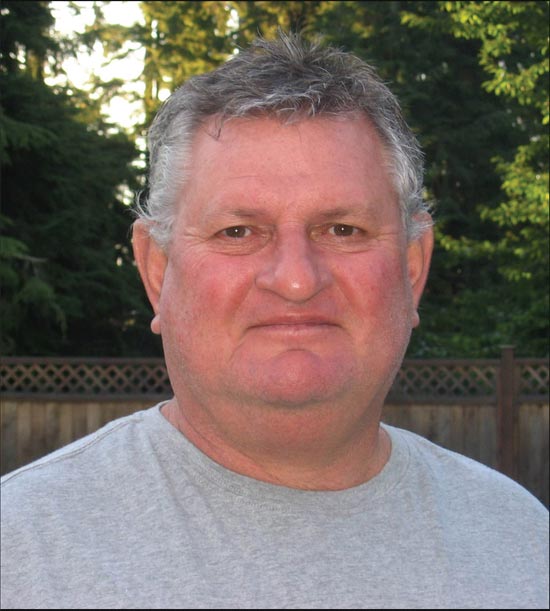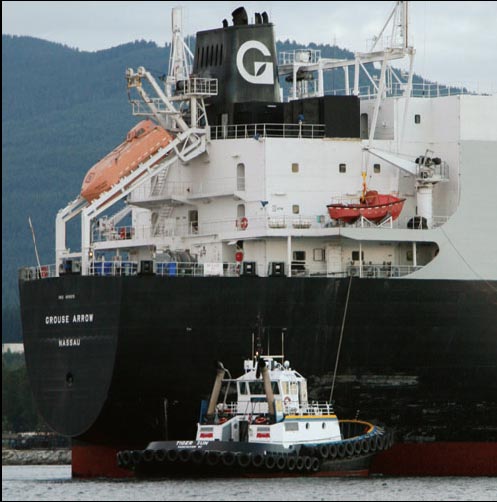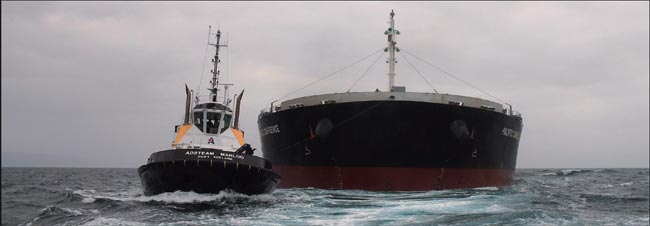On the job
Real world people working on the water
Authored by: Margaret Boyes
Brought to you by www.dieselduck.net, comments to [email protected]
Ken Schmidt, Skipper, SMIT Harbour Towage
 After
more than 40 years in the marine industry, Ken Schmidt is a tug
skipper with a tremendous depth of experience. When Mariner Life
caught up with him he was on leave from his job, recovering from a
minor stroke, but was looking forward to getting back to work soon.
On the water he puts his experience to use skippering SMIT’s Tiger
Sun in Vancouver and training ship docking tug skippers around the
world. This is especially valuable as the marine industry now faces
a shortage of skippers in all occupations.
After
more than 40 years in the marine industry, Ken Schmidt is a tug
skipper with a tremendous depth of experience. When Mariner Life
caught up with him he was on leave from his job, recovering from a
minor stroke, but was looking forward to getting back to work soon.
On the water he puts his experience to use skippering SMIT’s Tiger
Sun in Vancouver and training ship docking tug skippers around the
world. This is especially valuable as the marine industry now faces
a shortage of skippers in all occupations.
On The Job: Tell us about your current position. What does it involve, how long have you been doing it and what are the challenges?
Ken Schmidt: I’ve done ship berthing since 1980 with other companies, and have worked at Tiger Tugz (now SMIT Harbour Towage) for 12 years and operated ASD tugs. I’ve been employed in the marine industry since l967. Most of our work is ship berthing, from huge container ships to small tankers and navy ships and such.
Our work environment is controlled by whatever the pilot’s demands are. Our skill levels have to be set high to meet the challenge of helping the pilot as far as positioning the ship. Plus the rate of speed that is required to perform these functions may be higher than our comfort level, so when we’re training we always try to increase our comfort zone. That way we can always meet the demands of the job no matter what the circumstance - we can always be in a position to help them if something out-of-the-ordinary should happen, such as they’re going to hit the dock, or can’t stop, or their steering goes hard over or they’re going to run aground. That’s the tug’s responsibility when ship berthing, therefore you need to always do an excellent job.
So even in adverse conditions like when a ship is in English Bay and dragging anchor in a 50-knot westerly you go out there in choppy seas conditions and put your tow line up on the ship and keep it off the beach. Working in adverse conditions is hard because people are involved, there are hands working with lines and they have uneven footing so their balance may be compromised by not having a level platform to work on. We have to create as level a platform as possible so that people can work at their best in these conditions. Even in moderate conditions, when we have longshoremen on board they’re not used to small tugs or to movement under their feet, so if anything unusual happens they can go a bit sideways and easily lose their balance.
As a seaman, a lifelong skill you learn is always be braced while on the water. Even when you’re on the dock or the deck you’re always being braced because there could be a wave or you could bump something. Ship-berthing work is mostly done with the bow of the tug pushing and pulling a ship into position and not being braced could put you in a dangerous position. One challenge is putting the tug where you want it when everything is moving around you and you have to move with forces like the weather and sea conditions or the ship’s speed. We have to put the tug in a position so we can put the towline line up to the ship.
In the year 2000 I was approached by the Ports of Auckland because they were building their first Z-Drive tug and it was a very different type than they had previously. The Z-Drive tugs don’t have any skeg underneath them which allows them to go sideways (side step) at eight knots. Most tugs go bow first and don’t go over 10 knots. They build tugs today that do escort work and do 16 knots but we don’t have them in Vancouver yet. But the Z-Drive lets us work on the ship at various speeds and still get a solid, hard pull on our tow line by keeping the boat at a greater angle than a conventional boat could be. A standard skegged boat at three-and-a-half knots you can’t pull off at any degree of an angle. She’s going to just pull back which is really not what the pilots need. A Z-Drive tug is an outstanding tool for a skipper and better than anything we’ve had before because you always are able to apply a higher bollard pull when working at greater angles.
ML: Why did you choose this job? What route have you taken in terms of education and experience?
Schmidt: I’d never been on the water at all, not even on a ferry. I was delivering Chinese food and someone said they need people at Lyttle Brothers Towing. I went to apply and when I opened the office door there was Ron Westmoreland, the fellow who ordered Chinese food from me on Friday nights. He hired me on the spot. I soon fell in love with the freedom and the beauty of the water and the type of work. The work is always different. I started with log towing and barges but didn’t stay a deckhand long. I was an energetic, hard working guy so the boss kept pushing me higher. In 1972 when I had enough sea time I got a 350 ton Masters’ certificate. I’ve followed the program and did what I needed to keep my levels up. I have experience on local boats and have gone all over the country for Seaspan on outside tugs. I’ve been up to Alaska and down as far as the Panama Canal on oceangoing tugs. Then when I wanted to be home with my family I did ship berthing on the Fraser and in Vancouver Harbour. It’s the cleanest tug masters’ job but very challenging. You’re always working at someone else’s speed and comfort level.
ML: What does it take to succeed in your job?
Schmidt: Common sense and good judgment are, I believe, the two most important qualities needed. There are high and low levels we operate at; the better judgment and common sense you have the more you adjust to what’s happening around you. The rest can be taught.
ML: If there was anything you could change about your job what would it be?
Schmidt: The circumstances we work in are difficult so that’s one thing I’d change. Most shipping is done between midnight and 6:00 a.m., so when the average person is sleeping I’m working. Longshoremen start work at 7:00 a.m. so ships are in position by eight and longshoremen try to finish them by midnight when they go home. It was like that when I started working but today they work 24 hours.
ML: What are your aspirations for growth in your job?
Schmidt: I’d be happy just to go back to work. Through all this training I’ve worked with different architects and companies on brand new designed equipment. I’ve enjoyed being on the leading edge of all the new technology. The tugboat industry is always evolving.
There’s never only one type of tug. There used to be a one-purpose tug that did one thing very well. Now with so many new developments there are multipurpose tugs. Architects have to design tugs with different features to accommodate the world’s shipping needs. A multipurpose tug speeds ship berthing up and horsepower today has gone through the roof. If ships have a problem with wind or a damaged dock or bent crane it’s all downtime for their ship. And there are legal costs trying to fix it all up after they leave. So what they want now is a harder push off than they’ve had before so they can work in more extreme conditions.
Ships are much larger and we’re a little tugboat. 3,500 horsepower used to be a lot. When I grew up we started at 450 horsepower. But today tugs have 4,400, 5,000, 6,000, and 8,000 horsepower, just going up and up. New operators don’t have years of experience of working on single-screw tugs and small tugs. They can run a really good Z-Drive tug but they’re more power orientated today. Before, our tugs were so small and the barges so big and we had no horsepower to stop them or control them like they can today. We had to make sure we were in the right position to make all this happen; but with new style tugs you can go straight in and stop it. A new operator today has to be taught that skill because they had no one to learn from. They’ve just driven a Z-Drive tug.
ML: Do you train only previously qualified skippers in the nuances of tractor tugs or do you also train newbies?
Schmidt: I’ve trained seamen from absolute beginners to the 30-year veterans, world wide.
ML: What was your most memorable moment on this job?
Schmidt: (Laughs.) One of the more exciting ones was in Australia
where I was teaching people how to hook up on the bow of a ship
going backwards at speed. It was in a rough sea and we were doing
eight knots. We drove the tug in a stern up position and had to put
our bow right in front of the ship right on his bow to put our
headline up in order to help him go around a corner. That was
exciting but as far as memorable it’s hard to say. I have many good
memories of dolphins and
whales dancing around the boat.
 ML: If you were
retired or not going back to work, what would you be doing?
ML: If you were
retired or not going back to work, what would you be doing?
Schmidt: If I wasn’t ill, I’d be working at Tiger Tugz. I used to bank a lot of time and then use my holidays for training in other countries whenever a company was building a new tug and needed training. I’ve trained something like 150 guys now. I never enjoyed looking at water when I was younger - it reminded me of work and back then I had so many other things I wanted to do. Since then I’ve changed my attitude and absolutely love the water views. So one of my aspirations is to own a motor home, travel around and go fishing and never be very far from the water. Also I’ve been coaching sports for about 28 years now, mostly minor girls’ softball.
ML: What are your thoughts about the future of your profession?
Schmidt: There have been monumental changes in the last 10 years. I think there’ll be bigger tugs for ship berthing because ships are getting so large. There’ll be new ideas - for example they put a fin on the forward end of skeg on the tug. When you steer the tug off to one angle it helps steer the ship one way and the fin starts rolling in the same direction. Water comes around the dead side of your tug and fills that void space of water faster. This makes the indirect towage part of this tug a great feature because it has so much drag it’s like dragging a sea anchor. The ship turns as you go out to a larger angle and it’s a much higher bollard pull applying a greater amount of tow line force out of the tug with less horsepower being used. It’s like a plunger that’s put in water and pulled out square straight up and just sucks harder.
Z-Drive tugs are replacing the old tugs. The cost of them is less than a Voith Schneider, the first type of the indirect capability for tugs, a beautiful tug, fantastic but the cost of building it is anywhere from a $1.5 to $3 million or more. They’re basically built to help steer the ship for escort work. If the ship goes off course you can just steer off the angle, go forward on a tow line and steer the ship yourself. This is what the shipping companies world wide are looking for now.
Since the Valdez oil spill we’re waking up to this type of disaster because of the liability, and everyone wants this feature on the tug now. They want tugs that indirectly steer the ships at higher speeds without slowing it down. So you steer at an angle and directly steer them. That’s an interesting thing to do that’s really a challenge because there’s a fine line when you get it just right or not. You can feel the rope getting tighter and you are on just the right angle when you’re into the proper position for the hardest pull. You’ll know the feel when you are there.
They’re doing it now. Seaspan will soon have a new tug designed by Robert Allan. They want to escort these ships from Roberts Bank to Victoria. Robert Allan has a design where he’s put sponsons on the outside of the hull of the tug and it goes over so far and there’s an extra piece of metal that sticks out. It makes it more buoyant so it won’t sink when you do this. It looks dangerous but as long as the tug’s not going to roll over it’s not, this is where I see our industry is going to go. We have the most modern stuff now, including electronic charts on board that do a lot of the work.
ML:Tell us about some people in your line of work who you admire.
Schmidt: My greatest influence was probably Norm Findley. There’s always a strong possibility of damage in our industry. I worked with Norm for two years and he never came close to having the smallest mishap. He was such a good operator and taught me safety practices that I teach today. They are basically two things - aim wide and go slow.
ML: Do you have any advice for people who’d like to do your type of work?
Schmidt: When I grew up in this industry if anything was bigger than me I got out of its way. I survived that way and that’s how we did it back then. We could do things then without certification but afterward I went to school and learned what I should have known. One of the things I always tell my students is “experimentation reaps great rewards.” Always challenge yourself - just because it has been done a certain way for years it doesn’t mean it’s the only and best way. Always put safety first and try to leave yourself an opportunity for a way out. Have fun and stay safe!
